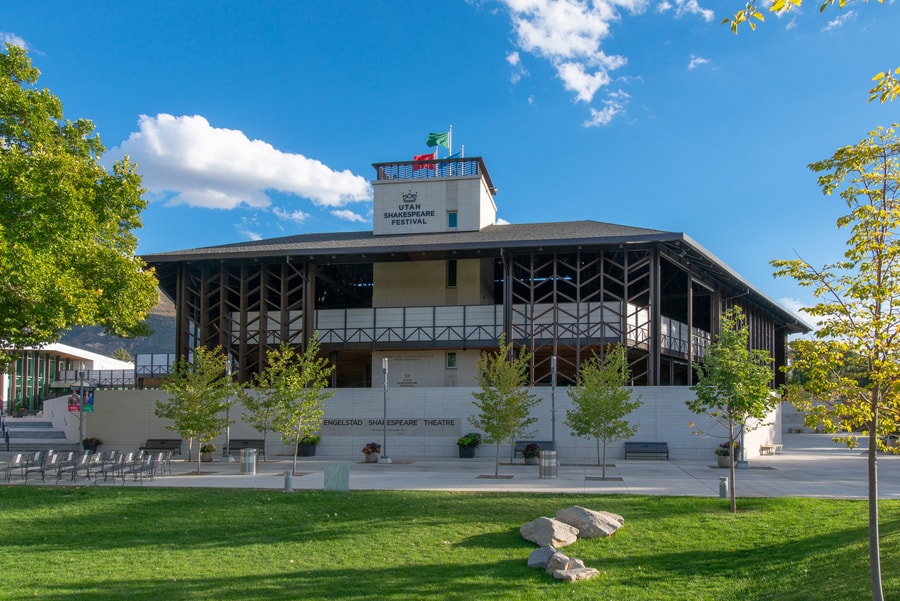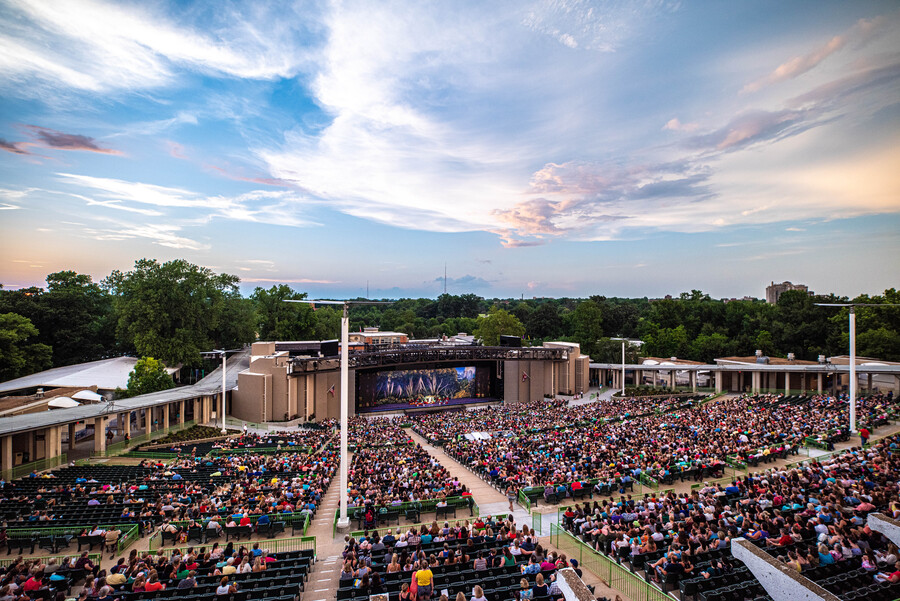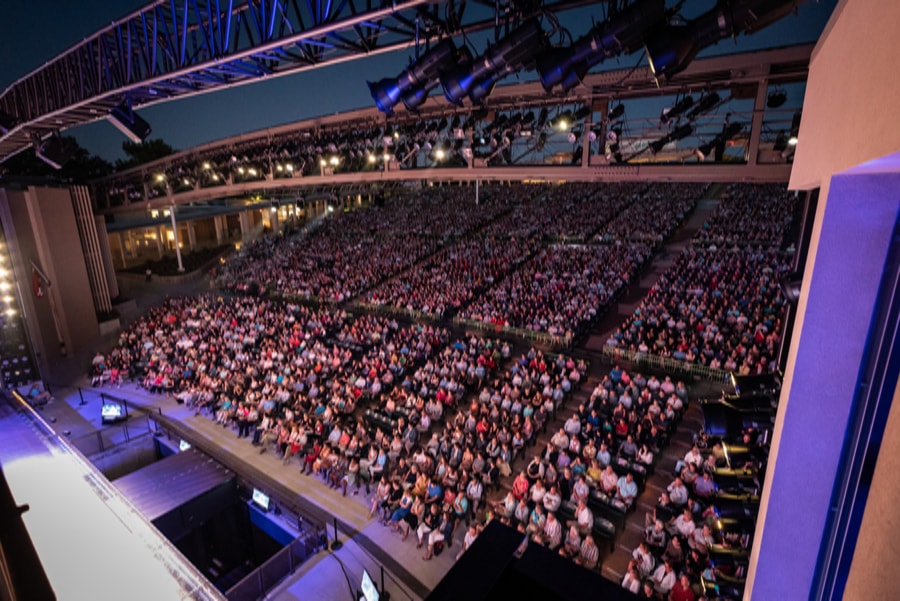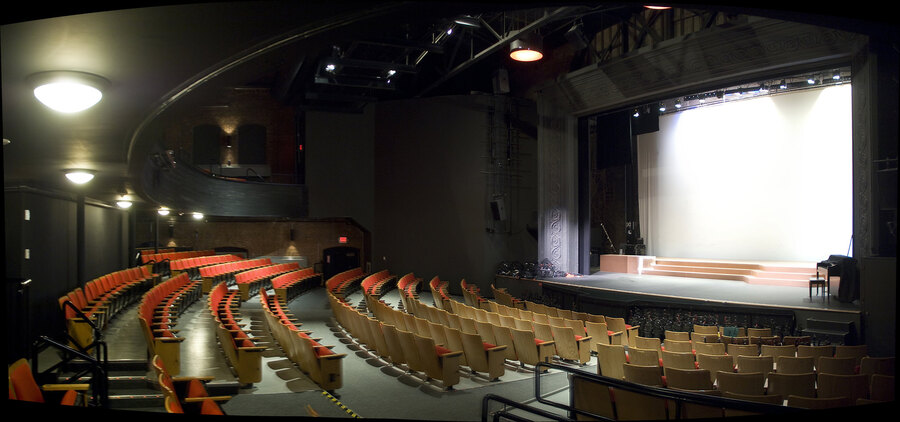“Fluid” seems to be the word of choice for some theatres as they end a spring schedule that never was, and look toward summer and fall slates that increasingly look like they may never be. Optimism—to the extent it exists at all—floats on a spectrum between “cautiously” and “overly,” while realistic expectations and projections change by the minute.
As recently as yesterday morning, for instance, the Utah Shakespeare Festival’s website was adorned with a banner declaring “the festival curtain will rise this summer”—a banner that has since been removed, replaced by the news that Utah Shakes will in fact not produce this summer. While many summer festival theatres have similarly canceled their summer seasons, from Oregon Shakes to Alabama Shakes to New York City’s Shakespeare in the Park, the St. Louis Municipal Opera Theatre (the Muny) has set a June deadline to decide whether to go forward or not with a summer season, to start in July at their 11,000-seat amphitheatre. And in Massachusetts, Barrington Stage Company has announced a “socially distanced” season to bow in August.
This is in sharp contrast to decisions at other theatres: The Minneapolis powerhouse Guthrie Theater recently announced they were slashing their 2020-21 budget and cutting onstage programming down to three productions to hit the stage in March 2021. Meanwhile in New York City, the Broadway League just announced an official further postponement of activity until at least Sept. 6, and at least one anticipated revival of the now-shuttered 2020 season, Plaza Suite starring Matthew Broderick and Sarah Jessica Parker, has officially moved its first curtain to March 2021, a full year after its planned opening. Broadway League president Charlotte St. Martin, according to the report from The New York Times, says that Broadway will return when New York Gov. Andrew Cuomo says it is safe to return.
Safety has been at the forefront of messaging from Actors’ Equity Association ever since pandemic-related theatre closures took hold. Just last week Equity president Kate Shindle took part in a press conference with leaders from many of the country’s major arts and entertainment unions, including Stage Directors and Choreographers, Directors Guild of America, Screen Actors Guild, American Guild of Musical Artists, and International Alliance of Theatrical Stage Employees, among others. During that call, Shindle highlighted the unique nature of an actor’s job in light of current health risks.
“Historically, there is no such thing as social distancing for our members, particularly the actors, regardless of the size of the audience,” Shindle said. “It’s one of the only workplaces in which it’s not only legal but expected that you will kiss your coworker as a condition of your job. I think we’re going to see theatres and employers being creative with how they use our members in new and innovative ways. But we have to know it is safe onstage and backstage in addition to in the audience before we are comfortable that it’s safe to go back to work.”
It was this conversation around safety that turned Utah Shakes’s determination to produce this summer into the resigned realization that programming will need to wait a while longer. According to a statement released Tuesday afternoon by Utah Shakes confirming the cancellation of their 2020 summer season, the festival reached out to Equity last week to inquire about the availability of contracts so they could start rehearsals on June 15. Despite changes made by Utah Shakes to adjust the schedule, seating, staff, costuming, and sanitation procedures after consulting with public health officials, the theatre was informed that Equity, which recently announced a partnership with former OSHA head David Michaels, would not be issuing contracts until their new safety guidelines (as advised by Michaels) were in place.
“We faced lots of obstacles,” said Utah Shakes executive producer Frank Mack, “and we were just trying to solve them as they came along, including the state plan called Utah Leads Together 2.0.”
Utah Leads Together 2.0 is the second version of the state’s task force plan to recover from the coronavirus fallout, laid out by Gov. Gary Herbert. Utah Shakes, Mack explained, had the precautions in place to move forward under these guidelines, including reducing their house size from 900 down to around 225. The company had what seemed to them reasonable optimism about a potential summer season, especially considering the relatively mild coronavirus toll in Utah. In a report released by NPR, the Harvard Global Health Institute calculated how much COVID-19 testing a state would need to test all of its infected population, plus any close contacts who may have been exposed to the virus; according to the report, only nine states are near or have exceeded the minimums estimated by that Harvard study, and Utah is among them. (These calculations, though, come with a number of caveats, including the reminder that things can get much worse very quickly should proper precautions be completely disregarded.)
When it came time for Utah Shakes to approach Equity, the last major hurdle between the company and a season, Mack and his team provided a comprehensive plan: There was to be a period of quarantine for everyone in the seasonal company, testing, a full-time health monitor, intensive sanitizing and disinfecting, and more. Only during rehearsal and performance, Mack explained, would the company and crew not be social distancing. Still, he said, he considered Equity’s decision fair, condeding that “it just wasn’t time yet.”
“It was something we fully understood and accepted,” Mack continued. “The timing just wasn’t going to work, because we couldn’t really wait any longer. We had to get this stuff organized by about a month before first rehearsal because we had housing obligations we needed to commit to, a build crew, designers, and directors—we sort of couldn’t put all that on hold any longer. We had to actually commit, and at the time we had to actually commit, Equity did not have their safety guidelines done yet. It was clear that the timing just wasn’t in the cards for us this summer and we don’t think it’s anyone’s fault.”
So the Cedar City company is turning its attention to its 60th anniversary season in 2021. And though the company stated in their release that they will be issuing full refunds to ticket buyers—as well as the option to roll tickets into donations or 2021 ticket purchases—Mack said the company is in a good financial position as they look toward 2021.
The Utah Shakes domino may have fallen, but a few still remain standing, however shakily. Kwofe Coleman, managing director at the Muny, used the word “tentative” to describe his company’s hope to have a summer run by pushing their opening date back to July 20 rather than June 15 and cutting their planned seven productions down to five. The company has set a firm date of June 8, by which time they will make a final up-or-down decision on their summer season.
“I don’t think it does anyone any good to keep kicking the can down the road and giving half information,” Coleman admitted. “We spent a lot of time as leadership, and with our executive committee of the board, together to decide: Here’s a timeline that we’re comfortable announcing and sticking with. We know that whatever the result is on that day, we’ve prepared for.”
As a company used to staging large-scale musicals with just 11 days of rehearsals, the Muny’s concerns are less about whether they’ll have productions ready to stage—especially since they already bumped their most tech-heavy productions, Mary Poppins and Sweeney Todd, to next season—than about the safety of their patrons and the value of putting on a shortened season. As a large outdoor venue, the Muny finds itself in the enviable position of not having to ask theatregoers to cram into a confined indoor space for two-plus hours. Still, as Coleman points out, even if restrictions on large gatherings begin to be lifted—as some states across the country, including another Midwestern state, Indiana, are already beginning to explore—for a venue as large as theirs, gatherings under a certain cap may still not be financially viable.
“For a lot of institutions and businesses, a thousand people is a lot,” Coleman said. “But if there’s a gathering restriction of a thousand people, that’s less than 10 percent of our house.”
As a seasonal outdoor venue, Coleman explained, their sleeping giant of a venue is put to rest during off season; to wake it up each summer is no easy task, and to do so for a 10-percent capacity season is a daunting prospect. The Muny has been hearing from patrons who are hopeful that the company will be able to do something—anything—this summer. Even the announcement of their tentative five-show plans and the June decision deadline has brought gratitude from patrons.
“I think we always aim for the most transparency with the community that we serve,” Coleman said. Even more important, though, is that community’s safety. “If the best choice for public health and public safety is that there’s not a season this summer, we will take a significant financial hit. I can’t stress that enough. But we’ve been in a relationship with this community for a long time, and hopefully some support still comes in from a donation standpoint. We will be back. And to be able to say that, knowing that going in, we recognize as a gift in and of itself.”
Meanwhile Barrington Stage Company, in Pittsfield, Mass., has made drastic changes to preserve a version of its summer and fall season, beginning in August. Artistic director Julianne Boyd, recalling a 2016 production of The Pirates of Penzance for which the theatre removed seats from the center of the company’s 520-seat theatre to accommodate the staging, got the idea to go a step further. Boyd’s company has removed over 350 seats from their mainstage theatre to take the space’s capacity down to 163–a number that’s close to the theatre’s 136-seat second theatre, but in a larger overall space, hence with more room to breathe.
“The moment I thought of it as a ‘stage two,’ it started making financial sense,” Boyd said. “I couldn’t do the kinds of shows that I normally do there, nor did I want to. I was thinking of how many actors I can have on the stage with social distancing.”
A revamped schedule soon took shape. Early August will feature David Cale’s one-man show Harry Clarke, as well as two one-night-only solo cabaret performances by Marilyn Maye and Ann Hampton Callaway. September will continue the trend, with Mark St. Germain’s one-woman show Eleanor and a solo performance from singer/actor Leslie Kritzer. All proposed shows, Boyd pointed out, require minimal (if any) rehearsal, limited technical rehearsal, and next to no production requirements. The stage crew, Boyd explained, was even being pared down to the necessities, with just one stagehand, plus the stage manager and a technician in a booth large enough to accommodate six feet of separation.
These adjustments are also taking into account the audience, which will be able to enter from three separate entrances for the three distinct sections of seating. Other gestures: None of the performances on the new slate have an intermission (hopefully eliminating any long bathroom lines); the theatre has moved the box office outside; and doors to the theatre will open early in an effort to prevent gathering at the entrances. The removal of a significant number of seats and rows from the theatre also means the elimination of the close encounters of squeezing past others to get to a seat in the same row.
“The other thing is, people have to wear masks,” Boyd said, acknowledging the theatre has to be prepared for the challenge of enforcing such a rule. “They’re wearing them everywhere else. This is the new norm. It would be weird to wear a mask everywhere and then all of a sudden take it off in the theatre.”
Also included in the theatre’s planned 2020 offerings are an outdoor concert of South Pacific, featuring no contact among the performers involved; an October mounting of Arthur Miller’s The Price; and a 10-minute play festival, which happens to have just two plays requiring physical contact. Those plays have been restaged, Boyd said.
“We looked at all the guidelines,” Boyd said, “all the federal guidelines and state guidelines. We talked to doctors. We talked to everyone that we thought would be helpful and they agreed.”
In addition to these precautions, Barrington Stage is cutting all two-show days, including on matinee days. These steps, Boyd emphasized, were not chosen hastily or lightly. While the plan the company has in place works financially for this summer, Boyd said, she hopes they don’t find themselves in the same position next summer.
“It’s scary to think of new ways of doing things when you’re not working with a full deck,” Boyd explained, noting that for theatre to continue, it will need to change from what it was only a few months ago. “You don’t have the budget, you can’t put the number of actors you want on the stage. It makes you rethink things.”
At this moment, the perfect step forward is nearly impossible to see, and there may not be a one-size-fits-all solution in any case. Even the Guthrie’s artistic director Joseph Haj acknowledged that the cautious approach of pushing reopening to March 2021 could wind up being seen as optimistic, depending on the progression of the pandemic. There’s still the possibility that, should the universe “smile on us,” as Haj put it, programming could be added back into the theatre’s schedule before their stated opening date. In the meantime, the old adage (or perhaps the exhausted stereotype) continues to ring true—that theatre will find a way to adapt. Whether it’s San Francisco’s PlayGround working with SAG-AFTRA to put 140 actors on contract for a digital streaming festival called PlayGround Zoom Fest, or Los Angeles’s Geffen Playhouse working with illusionist Helder Guimarães and, oddly enough, the postal service to provide a virtual and interactive production, theatres are continuing to find innovative ways to approximate theatre-by-other-means until it’s safe to get back on physical stages in front of audiences.
What we’re learning, as theatres venture further into the unknown, is the importance of looking inward to find the best steps forward for their workers and their audiences. Many may not have the flexibility of a Barrington Stage or the budget of a Guthrie, but, as Barrington’s Boyd said, “We have to rethink what the theatrical experience today is. Do we stop doing?” Boyd wondered rhetorically. “Do we stop doing theatre until we find that perfect answer or we find that vaccine? Or do we find a way? Maybe this will lead other theatres to something else. I think there has to be a first step, and we’ve taken a long time to figure this out.”






